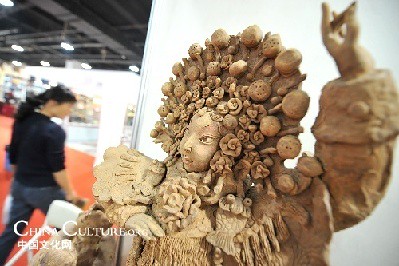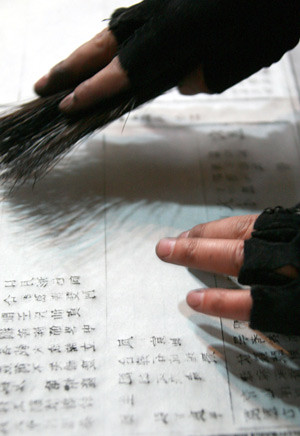| Home > Living in China > Art |
The Dawn Breaks
(the prehistoric period - the 16th century BC)
Ancient documents trace the history of Chinese music back to the Yellow Emperor However, this is not completely reliable, as the legends about the Yellow Emperor are mixed with much material from the ideologies of later times (for instance, it is said that the "twelve tones" were formed in the time of the Yellow Emperor, but this attributing of a later creation does not accord with scientific archeological findings). Moreover, the tendency to credit the Yellow Emperor with being the originator of Chinese music would seem to put too late a date on the emergence of music in China. Modern archeological findings have extended the history of Chinese music to a time much earlier than that of the Yellow Emperor.
In 1986 and 1987, a New Stone Age site at jiahu Village, Wuyang ounty, Henan Provinceyielded21 bone flutes from a grave.
|
|
According to the latest comprehensive dating methods, they are 8,000-9,000 years old. They are all made Out of the ulna bones of a type of crane, and most of them have seven holes. Beside some of the holes there remain the traces of notations engraved before the holes were drilled. Also beside one or two holes is a smaller hole which seems to have been used for regulating the pitch. From this we can see that at the very least people at that time had an elementary knowledge of the connecti0n between pitch and the length of a flute. Musicologists have done tests on the most intact one 0f the flutes, (Fig. 1 -1 ) and found that there was a firm concept of the so-called pentatonic scale in China as early as 8,ooo years ago, and that this was the main scale, but music was not confined to this scale. (This fact eloquently testifies to the fact that China's use 0f the pentatonic scale as the main scale was not a matter of human whim, or so-called "defect in the development of the scale-', but was a result of historical and esthetic selection.) It is also evidence that Chinese music at that time had reached a comparatively high level, far higher than people imagine. Prior to this, Chinese music must have existed for a very long period of time, perhaps 1 0,000 years, but it is difficult t0 get any concrete idea about its nature.
Apart from bone flutes, musical instruments discovered from the New Stone Age include bone whistles, ocarinas, ceramic bells, stone chimes and drums. Such instruments are found scattered across the country, and they date from a very long time span, showing that they were the principal musical instruments in primitive times in China. Of them, bells, stone chimes and drums were developed vigorously in later ages. As for ocarinas and whistles, and even flutes shaped like the old bone flutes, still exist among the people. They are in principle the same as the ancient instruments, though nowadays they are called Chou Ocarinas were made of baked clay. They were usually egg-shaped (although other shapes are found), and about the size of the average man's fist. They were hollow inside, and at one end there was a hole for blowing into. On the body of the instrument were one or several finger holes. Apart from the bone flutes, the ocarinas were the only primitive musical instruments which could definitely produce more than one note; two to four notes from one to three note holes (This very possibly has something to do with the fact that it is more difficult to calculate how many holes it is suitable t0 make in a small, egg-shaped ocarina than in a tube-like flute). Over a certain period of time, they embodied the progress of the Chinese scale. They especially reveal the relations between pitch intervals which occupied an important place the course of development of the Chinese scale. That is the minor thirds which had been repeatedly stressed since the emergency of one-hole ocarinas, which could only produce two notes, according to modern scholars. The view doubtless has important significance for an understanding of the connection between the notes of the scale, the development of the Chinese scale as well as the internal mechanics of the phenomenon that China's seven- note scale takes the pentatonic scale as it skeleton.
Primitive music was inseparably connected with dancing. This is probably a phenomenon which has occurred in the histories of all the peoples of the world, and China is no exception. in the zhou Dynasty which began in the 11th century BC, at the latest, the art form which combined music and dancing was called yue in China. And when music and dancing became separate art forms later, yue could still refer either to dancing or to music, preserving the vague meaning. Nowadays, We refers specifically to music, so scholars use yuewu to describe primitive yuc. Some primitive rock paintings available now depict, in a most life- like manner, scenes of primitive performances of music and dancing in groups. In later documents are found fragments of "recollections" which reveal that primitive singing and dancing were intimately bound up with sacrificial rites and prayers for good harvests, and therefore must have contained features of productive activities. primitive times, music and dancing were not objects of division of labor, and there was no specialized class of musicians. Music and dancing were activities involving the whole of tribal society As a consequence, there were no special features or identity for artistic forms, independent of society.
Strictly speaking, it was only after the founding of the Xia Dynasty, in about the 21st century BC, that music and dancing truly participated in the social division of I8bor, and became independent aspects of society. lt is said that the founder of the dynasty, Qi, and the last ruler, and dancing for their own enjoyment, which indicates that there had already emerged a large class of specialist musicians and dancers, and marks the emeopnce of music and dancing as independent arts.
Because primitive music and dancing were intimately c0nnected with shamanism and religious rituals, it is probable that the idea of there being something Supernatural about music and dancing and musical instruments emerged at a very early period. Following the formation of the state, the rulers made use, and stressed the notion, of the supernatural power of music and dancing to bolster their grip on power, and so they manipulated and controlled these activities. Some myths concerning music and having this kind of social background have been handed down. A legend goes that the larp-scale dances known as jiuban and jiuge had been obtained from Heaven by the Xia ruler Qi. WC can see a portrait of Qi on a musical instrument excavated from an early Warring States (fifth century BC) site. From this, it seems that Qi had the status of guardian deity of music by that time. An0ther legend has it that the Yellow Emperor had a drum covered with the skin of a tusked animal called kui When he beat the drum using a bone of the Thunder Beast, it was said that it could be heard for 5oo li(Two Ii is equal to 1 km). He used the drum to exert his sway over the empire. The tW0 animals referred to were both mythical beasts, and at that time, as in later ages, drums were in fact covered with oxhide. But sometimes, the hide 0f what was probably the Yangtze alligator was used; and so divine qualities were attached to the alligator too. Later, the kUias transformed into the deity who presided over music. This account of the animal whose skin was used to cover a sacred drum becoming the god of music should be regarded as an indirect reflection of the leading position of the drum, which set the rhythm for all the other instruments.
It is notable that the spot where the bone flutes were unearthed is very near the Mound of Xia, which appears in a legend pertaining to the Xia Dynasty. Therefore, Xia arose on territory in which Chinese music was already very highly developed. Legend has it that music and dancing in the Xia Dynasty flourished as never before; this is completely understandable. lf we peel away the superstitious element from the account of the jiuban and the jiuge, i.e., that Qi received them from Heaven, what we are left with is the impression that these were dances of exceeding beauty It would only be a short step from dreaming that such dances "c0uld only exist in Heaven" to the creation of the legend.
Art
 more
moreThe Dawn Breaks
(the prehistoric period - the 16th century BC) Ancient documents

2008 World Craft Council General
The 16th WCC General Assembly was held in China’s southern city of

Traditional wooden movable
Villagers print the book of the Chen's family tree

Customs
 more
moreChinese Kungfu
Everybody was kungfu fighting
Niels Tsai, a kungfu enthusiast from Malaysia, was halfway up misty
Tai chi helps cut pain of knee arthritis
The traditional Chinese form of exercise known as tai chi can help
Kungfu Taste: Learn Martial Art in Shaolin Temple
The mention of Shaolin Temple conjures up images of a quiet and




 print
print  email
email  Favorite
Favorite  Transtlate
Transtlate 
